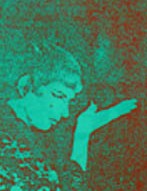Get audacity or any other decent audio editor
Synthesise a sine wave in the left channel of 440hz
Synthesis a sine wave in the right channel of 440+Xhz where X is whatever frequency you want to get to
Listen to it for at least 20 minutes with headphones
Focus on it
Enjoy
Sometimes mixing some music or pink noise can help if you find pure sine waves unpleasant. I've experimented with modulating the music itself and get some interesting effects, but only anecdotal evidence. If anyone would like an example try this:
http://shell.garethn...nauralbeats.ogg
Others who have listened to this claim it makes them feel a little bit sick, I find it greatly aids focus, but this may be due to the normal effect that music has upon me. I get a lesser effect with pure sine waves for focus, but have found that binaural beats at 440hz in the left channel and 444hz in the right channel can put me to sleep in minutes.
I avoid commercial binaural/relaxation/meditation/hypnosis tapes/CDs for several reasons. The most important one is that I don't know how effective they are or even if some kind of subliminal crap is in there.
I've got to say that I've found this thread extremely helpful and interesting. But I'm having trouble finding an accurate frequency chart for brain waves, since wikipedia itself has two opposing charts in articles that are related to each other. But they do have listed in one "The precise boundaries between ranges vary among definitions, and there is no universally accepted standard."
Anyway, if my understanding is correct, these would be the proper ratios for making Sine Tones for each type of brainwave.
~Examples of Sine Tones:*Delta: 440hz left & 444hz right
(4hz or less)*Theta: 440hz left & 448hz right
(4hz - 8hz)*Alpha: 440hz left & 452hz right
(8hz - 12hz)*Sensorimotor Rhythm: 440hz left & 456hz right
(12hz - 16hz)*Beta: 440hz left & 466hz right
(12hz - 26hz)*Gamma: 440hz left & 470hz right
(26hz - 100hz) (Difference must be 30hz or below)
And for a little side note: Gamma waves must not be attainable, or if attainable, just barely. Since the difference between the two frequencies must be small (below about 30 Hz) for the effect to occur; otherwise the two tones will be distinguishable and no beat will be perceived. And I've seen the Gamma waves placed at 40hz or more and 26hz or more, leaving little or no window.
Here are some useful links:
*
Binaural Beats (Or "binaural tones" are auditory processing artifacts, that is apparent sounds, the perception of which arises in the brain independent of physical stimuli.)
*
Electroencephalography (The neurophysiologic measurement of the electrical activity of the brain by recording from electrodes placed on the scalp or, in special cases, subdurally or in the cerebral cortex.)
{Scroll down to "Activity types" for the ranges of Brain Waves}*
Brainwave Synchronization (Also called "Brainwave Entrainment", the practice to entrain one's brainwaves to a desired frequency.)
*
Mind Machine (The process is also known as brainwave synchronization or entrainment, Mind machines typically consist of a control unit, a pair of headphones and/or strobe light goggles.)
{Using alpha frequencies with visual stimuli can trigger photosensitive epilepsy. 1,2}*
Neurofeedback (Also called neurotherapy, neurobiofeedback or EEG biofeedback is a controversial therapy technique that presents the user with realtime feedback on brainwave activity.)
Historically four major types of continuous rhythmic sinusoidal EEG activity are recognized (alpha, beta, delta and theta). There is no precise agreement on the frequency ranges for each type.
-Delta is the frequency range up to 4 Hz and is often associated with the very young and certain encephalopathies and underlying lesions. It is seen in stage 3 and 4 sleep.
-Theta is the frequency range from 4 Hz to 8 Hz and is associated with drowsiness, childhood, adolescence and young adulthood. This EEG frequency can sometimes be produced by hyperventilation. Theta waves can be seen during hypnagogic states such as trances, hypnosis, deep day dreams, lucid dreaming and light sleep and the preconscious state just upon waking, and just before falling asleep.
-Alpha (Berger's wave) is the frequency range from 8 Hz to 12 Hz. It is characteristic of a relaxed, alert state of consciousness. Alpha rhythms are best detected with the eyes closed. Alpha attenuates with drowsiness and open eyes, and is best seen over the occipital (visual) cortex. An alpha-like normal variant called mu is sometimes seen over the motor cortex (central scalp) and attenuates with movement, or rather with the intention to move.
-Sensorimotor Rhythm (SMR) is a middle frequency (about 12–16 Hz) associated with physical stillness and body presence.
-Beta is the frequency range above 12 Hz. Low amplitude beta with multiple and varying frequencies is often associated with active, busy or anxious thinking and active concentration. Rhythmic beta with a dominant set of frequencies is associated with various pathologies and drug effects, especially benzodiazepines.
-Gamma is the frequency range approximately 26–100 Hz. Gamma rhythms appear to be involved in higher mental activity, including perception, problem solving, fear, and consciousness.
Rhythmic slow activity in wakefulness is common in young children, but is abnormal in adults. In addition to the above types of rhythmic activity, individual transient waveforms such as sharp waves, spikes, spike-and-wave complexes occur in epilepsy, and other types of transients occur during sleep.
In the transition from wakefulness, through Stage I sleep (drowsiness), Stage II (light) sleep, to Stage III and IV (deep) sleep, first the alpha becomes intermittent and attenuated, then disappears. Stage II sleep is marked by brief bursts of highly rhythmic beta activity (sleep spindles) and K complexes (transient slow waves associated with spindles, often triggered by an auditory stimulus). Stage III and IV are characterized by slow wave activity. After a period of deep sleep, the sleeper cycles back to stage II sleep and/or rapid eye movement (REM) sleep, associated with dreaming. These cycles may occur many times during the night.
EEG under general anesthesia depends on the type of anesthetic employed. With halogenated anesthetics and intravenous agents such as propofol, a rapid (alpha or low beta), nonreactive EEG pattern is seen over most of the scalp, especially anteriorly; in some older terminology this was known as a WAR (widespread anterior rapid) pattern, contrasted with a WAIS (widespread slow) pattern associated with high doses of opiates. Anesthetic effects on EEG signals are beginning to be understood at the level of drug actions on different kinds of synapses and the circuits that allow synchronized neuronal activity (see: http://www.stanford....up/maciverlab/).















































